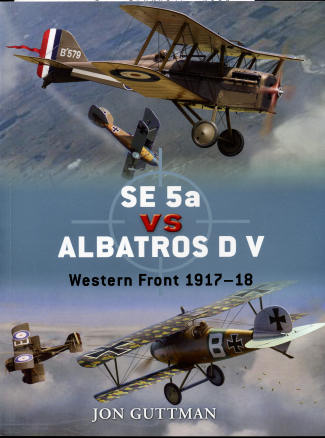 Nothing
like a war to spur on equipment innovations and one of the outcomes of WWI was
the rapid development of the airplane as a useful weapon of war. Osprey's
Duel #20 covers two of the world's more famous WWI protagonists, the British
SE.5a and the Albatros D.V.
Nothing
like a war to spur on equipment innovations and one of the outcomes of WWI was
the rapid development of the airplane as a useful weapon of war. Osprey's
Duel #20 covers two of the world's more famous WWI protagonists, the British
SE.5a and the Albatros D.V.
The book clearly states that of the two, the SE.5a was a
superior aircraft in almost all regards as it had ruggedness to be able to dive
and it had good speed and handling. While the Albatros D. III/V was no slouch in
speed or maneuverability, it had a single spar lower wing that was prone to
breaking if over stressed; such as in combat or high speed dives.
Yet the strategic situation in WWI was such that even with
those attributes, the Germans were at an advantage. German pilots rarely strayed
over the front lines, preferring the Entente power to come to them to fight,
which they did. The Germans also had the wind on their side as it most often
blew out of the west, meaning the British and others had to fly into a head wind
to get back home, making them somewhat easier prey if damaged or out of
ammunition. One also has to add into this mix that for the most part, the
Germans had better flying tactics than others. Most of the tactical innovations
in air to air fighting are a result of what the Germans discovered.
In addition to having a generally superior aircraft, the
British also had the advantage of only having to learn about the flying
characteristics of a few planes. During the time of this book, the majority of
fighters flown by the Germans were Albatros of some sort. Mostly D.III, D.IIIa
and D.V aircraft with a few Pfalz D.IIIs and Fokker Dr.Is in the mix. The
Germans, on the other hand, could meet up with SE.5s, Sopwith Pups, Spad VII's,
Nieuports of various types, Fe.2bs and at least a dozen other Entente fighters.
So learning all their different plusses and minuses was quite a challenge.
Needless to say, the Germans did well for themselves during
this time period often having a 3 to 1 or better success ratio.
In this book, as in all the Duel series, we get a look at the
development of both aircraft, their specifications and how their pilots were
trained. We also learn of some of the more famous pilots and their experiences
flying the various types. 'I was there' stories and snippets from official
squadron diaries give us some insight as to how well these folks did and the
situations in which they often found themselves. Of course, we are also treated
to a statistics section that shows how well each type did and how the success or
not of these aircraft led to other types.
As with others in this series, it has a
nice selection of period illustrations in addition to excellent artwork and
diagrams done specifically for this book. It is a first rate read and one that I most highly recommend.
December 2009
For more on the complete line of Osprey books,
visit www.ospreypublishing.com. In the US, it is
Osprey Direct at 44-02 23rd St, Suite 219, Long Island City, NY 11101., where you can
get a catalogue of available books.
If you would like your product reviewed fairly and quickly, please contact
me or see other details in the Note to
Contributors.
 Nothing
like a war to spur on equipment innovations and one of the outcomes of WWI was
the rapid development of the airplane as a useful weapon of war. Osprey's
Duel #20 covers two of the world's more famous WWI protagonists, the British
SE.5a and the Albatros D.V.
Nothing
like a war to spur on equipment innovations and one of the outcomes of WWI was
the rapid development of the airplane as a useful weapon of war. Osprey's
Duel #20 covers two of the world's more famous WWI protagonists, the British
SE.5a and the Albatros D.V.